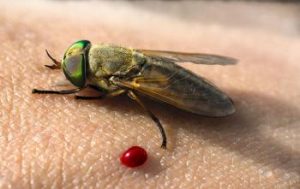Researchers See Greenhead Horse Fly as Indicator of Marsh Health
– JANUARY 29, 2016
The presence of a top predator of other invertebrates in Louisiana’s coastal marshes may shed light on how the marshes are recovering from the effects of the BP oils spill in April 2010.
(From eunicetoday.com / by Rick Bogren) — Almost immediately after the Deepwater Horizon began spewing oil into the Gulf of Mexico, LSU AgCenter entomologists Lane Foil and Claudia Husseneder headed for the Louisiana coast to start gathering data on coastal insects.
Foil joined the LSU AgCenter in 1980, when he began studying horse flies as vectors of diseases of horses and cattle. Husseneder’s specialty is insect population genetics. They combined their specialties and Foil’s knowledge of the Louisiana coast to study the effects of the oil spill. And they chose the greenhead horse fly as their research subject.
The greenhead horse fly is one of few insects that are native to and tightly bound to specific coastal marsh habitats in Louisiana. This insect inhabits coastal marshes that range from Texas to Nova Scotia.
Foil and Husseneder assumed that the prevalence of greenhead horse fly populations would be an indicator of the relative health of the marsh.
The researchers selected six locations along the Louisiana coast and began gathering population data on adult greenhead horse flies – a biting nemesis of people and animals alike – as an indicator of the health and recovery of the oil-damaged marshes.
As it turned out, oil from the spill reached three of the locations, and three remained “pristine,” giving the researchers the opportunity to compare how oil intrusion affected the marsh.
Using funding from the National Science Foundation, the researchers began their study by comparing horse fly populations in the unaffected marsh areas with those in areas subject to the oil spill. They then used population data and genetic analysis to evaluate and compare the health of the horse fly populations in the different locations.
The oiled sites were located on Grand Bayou, Grand Isle and Elmer’s Island in southeast Louisiana. Pristine trap sites were located in southwestern Louisiana – Ship Channel in Cameron Parish, Rockefeller Wildlife Refuge at the border of Cameron and Vermilion parishes and Cypremort Point in St. Mary Parish.
They collected adult horse flies from June to October in 2010 and 2011. In addition, they collected the predatory larvae in 2011 from four of the sites.
Read the full article here: http://eunicetoday.com/local/researchers-see-greenhead-horse-fly-indicator-marsh-health
GoMRI “In the news” is a reposting of articles about GoMRI-funded research (published by various news outlets).






